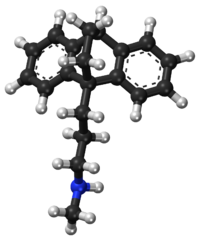Maprotiline
 |
|
 |
|
| Clinical data | |
|---|---|
| AHFS/Drugs.com | Monograph |
| MedlinePlus | a682158 |
| Pregnancy category |
|
| Routes of administration |
oral, intramuscular, intravenous (infusion) |
| ATC code | N06AA21 (WHO) |
| Legal status | |
| Legal status | |
| Pharmacokinetic data | |
| Bioavailability | 66–70% |
| Protein binding | 88% |
| Metabolism | hepatic |
| Onset of action | 6 hours |
| Biological half-life | 27–58 hours |
| Excretion | biliar (30%) and urine (57%) as glucuronides, 3–4% as unchanged drug |
| Identifiers | |
|
|
| CAS Number |
10262-69-8 |
| PubChem (CID) | 4011 |
| IUPHAR/BPS | 2402 |
| DrugBank |
DB00934 |
| ChemSpider |
23719117 |
| UNII |
2U1W68TROF |
| KEGG |
D02566 |
| ChEMBL |
CHEMBL21731 |
| ECHA InfoCard | 100.030.532 |
| Chemical and physical data | |
| Formula | C20H23N |
| Molar mass | 277.403 g/mol |
| 3D model (Jmol) | Interactive image |
|
|
|
|
|
|
|
Maprotiline (sold as Deprilept, Ludiomil, Psymion) is a medication that belongs to tetracyclic antidepressants (TeCA), a specific group of antidepressants.
Maprotiline was developed and has been marketed by the Swiss manufacturer Geigy (now operated by Novartis) since the early 1980s under the brand name Ludiomil. Generics are widely available.
After oral use absorption is good. It binds to plasma proteins 80–90%. Maximal plasma concentration is reached 6 hours after use. The mean time to peak is 12 hours. The half-life of elimination averages 51 hours.
Maprotiline exhibits strong effects as a norepinephrine reuptake inhibitor with only weak actions the reuptake of serotonin and dopamine. It is also a strong antagonist of the H1 receptor, a moderate antagonist of the 5-HT2 and α1-adrenergic receptors, and a weak antagonist of the D2 and maCh receptors.
Maprotiline has also more recently been identified as a potent antagonist of the 5-HT7 receptor, with this action potentially playing an important role in its antidepressant effectiveness.
The pharmacological profile of maprotiline explains its antidepressant, sedative, anxiolytic, and sympathomimetic activities. In accordance to the pharmacological characteristics it is used in the treatment of depression, such as depression associated with agitation or anxiety. Additionally, it shows strong antagonism against reserpine-induced effects in animal studies, as do the other 'classical' antidepressants. Although maprotiline behaves in most regards as a 'first-generation antidepressant' it is commonly referred to as 'second-generation antidepressant'.
...
Wikipedia
